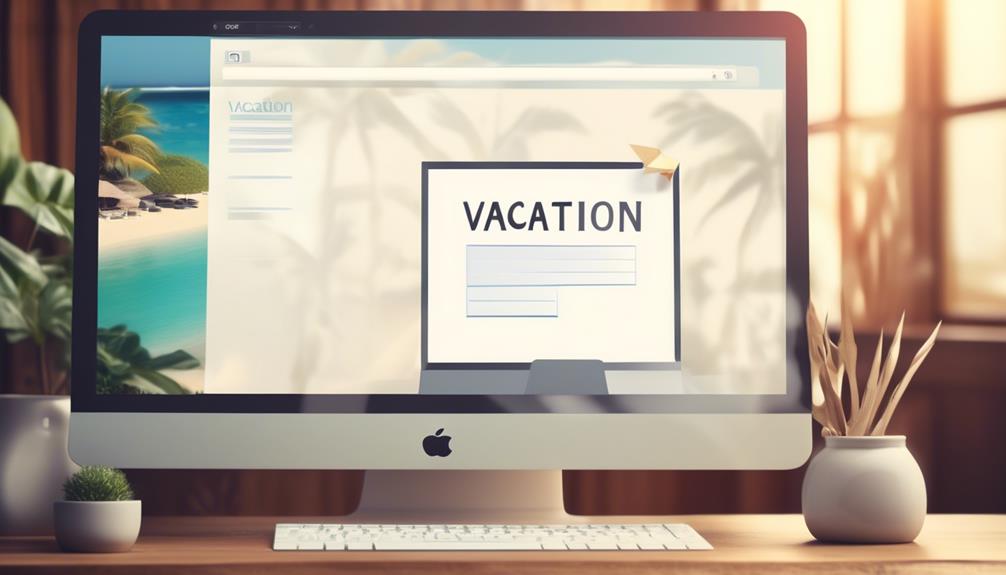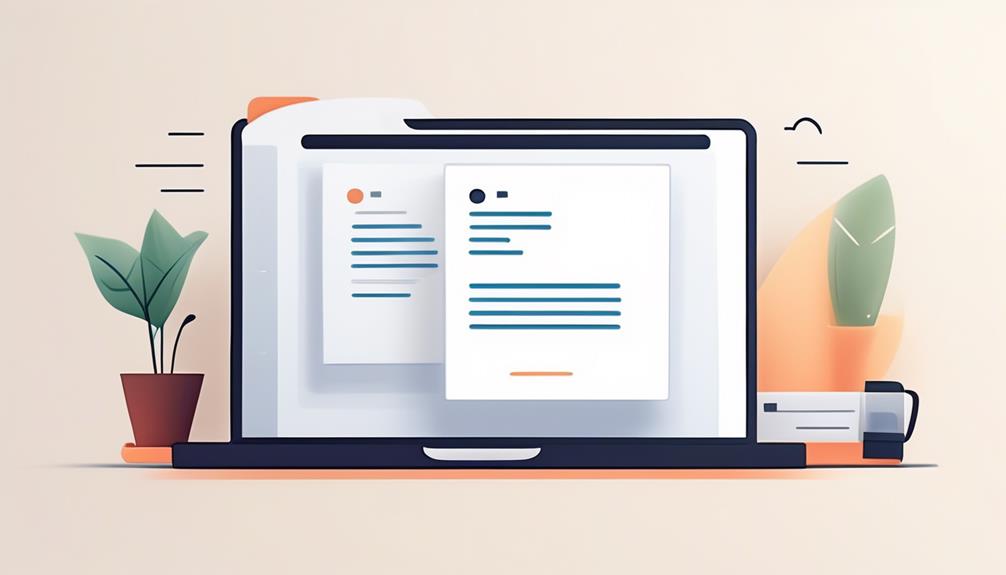Initiating the drafting of a maternity leave email, it’s essential to perceive this not simply as an announcement of time away. Symbolically, it signifies a transition phase, an occasion for us to seamlessly delegate responsibilities and ensure ongoing continuity.
The art of composing this email lies in not only communicating our leave dates and points of contact but also in setting the tone for our return. There are nuances to address, plans to solidify, and a sense of reassurance to convey.
Join us as we navigate the intricacies of composing a maternity leave email, ensuring that it not only serves its practical purpose but also leaves a positive impact during our absence.
Key Takeaways
- Clearly communicate the start date, duration, and expected return to work in your maternity leave email.
- Promptly inform colleagues and your employer of any adjustments or changes to your maternity leave plans.
- Provide contact information for a designated person who can handle work matters in your absence.
- Express gratitude and enthusiasm for the support and understanding during your maternity leave.
Crafting a Clear and Professional Message
When crafting a maternity leave email or letter, it's crucial to clearly communicate the details of our leave request. This includes specifying the start date, duration, and expected return to work. If plans change, it's essential to promptly let our colleagues and employer know of any adjustments to our maternity leave. Additionally, providing contact information for a designated person who can handle work matters during our absence is vital for a smooth transition.
Expressing gratitude and enthusiasm for the support and understanding of our colleagues and employer during this time is also important to include in the message. Proofreading the email or letter for clarity, professionalism, and accuracy is crucial to ensure it's well-structured and easy to understand. We should strive for a message that's clear, professional, and concise, while also conveying empathy and gratitude.
Setting Expectations and Plans

As we focus on setting expectations and plans for our maternity leave, it's crucial to clearly communicate the details of our expected return date and the duration of our leave, while also providing contact information for a designated point person during our absence.
Our expected return date to the office is [Expected Return Date], and we plan to take a leave of [Number of Weeks] weeks. During this time, [HR Manager's Name] will be our designated point person. You can reach out to [HR Manager's Name] at [Contact Information] for any work-related queries or support during our absence.
Additionally, we'll set up an out-of-office email to manage communication expectations and provide alternative contacts for urgent matters. We encourage everyone to plan and manage expectations in our absence, and we kindly ask for your understanding and support during this important time.
While on leave, we'll be available [Specify Availability] and prefer to be contacted via [Preferred Method of Communication]. Clear boundaries and expectations for contact and communication are essential for a smooth maternity leave transition, and we appreciate your cooperation in this matter.
Maintaining Open Communication
Maintaining open communication throughout our maternity leave is essential for ensuring a seamless transition and continued collaboration with our team. By keeping the lines of communication open, we can effectively inform our colleagues about our time away from the office and our plan for returning to work. This will help in maintaining a sense of continuity and ensure that our responsibilities are appropriately delegated during our absence.
| Contact Person | Responsibilities During Maternity Leave |
|---|---|
| Team Leader | Project oversight and decision-making |
| Co-worker | Daily task coordination and updates |
| HR Department | Leave-related inquiries and documentation |
| Backup Colleague | Temporary coverage for urgent matters |
| Mentor or Coach | Professional guidance and support |
Reaching out to the identified contact persons before our leave will facilitate a smooth transition, and we can also discuss the frequency and preferred mode of contact during our time away. This proactive approach will help us maintain a sense of involvement while on leave and ease the process of returning to work. Open communication not only benefits our team but also supports our well-being during this significant transition.
Tailoring the Email to Your Preferences

To ensure a seamless and tailored approach to maintaining open communication during maternity leave, it's important to customize the email based on our preferences and desired level of connection.
Here are three key steps to consider when tailoring the email to our preferences:
- Personalize the Content:
Tailor the content of the email to reflect our individual preferences for communication during maternity leave. This may involve choosing a tone and style that aligns with both our personality and the workplace culture. Additionally, consider the level of personal information you're comfortable sharing and whether you want to incorporate personal updates or baby photos.
- Clearly Communicate Availability:
Clearly communicate our availability, preferred mode of contact, and the level of connection we intend to maintain during our leave. This will help manage expectations and ensure that colleagues and supervisors understand how and when to reach out.
- Choose the Right Template:
Select an email template that best fits our communication style and comfort level with sharing personal information. Whether it's a formal, detailed email or a more casual and brief message, choosing the appropriate template is essential in reflecting our preferences.
Ensuring a Smooth Transition
We understand the importance of ensuring a smooth transition during my maternity leave. It's crucial to provide clarity on my absence and return to work. As such, I'll be on maternity leave for the next 12 weeks, with an anticipated return date of [Return Date]. During this time, I'll be away from the office, but I want to assure you that I'll be available via email on a limited basis.
To ensure that all responsibilities and inquiries are handled seamlessly, [Point of Contact] will be available to assist with any work-related matters in my absence.
In addition, I want to make it easier for everyone to reach out as needed. Therefore, I encourage you to contact [Point of Contact] for any urgent matters during my parental leave. I've also provided [Point of Contact 2] as an alternative contact for ongoing projects or tasks. This proactive approach aims to ensure that ongoing work progresses smoothly and that any urgent issues can be addressed promptly.
Thank you for your understanding and support during this time, and I look forward to returning to work and rejoining the team.
Frequently Asked Questions
How Do You Send an Email for Maternity Leave?
We send a maternity leave email by expressing our return date and availability, providing a point of contact, and outlining work coverage and delegation.
It's crucial to emphasize the importance of preparing an out-of-office message in advance and understanding HR policies.
Being empathetic and professional in the email is essential. It should convey our readiness to ensure a smooth transition and maintain open communication during our absence.
How Do I Mail My Boss About Maternity Leave?
We should approach our boss about maternity leave by initiating an open and honest conversation. We can express our gratitude for the opportunity to discuss our leave and explain our plans for transitioning our responsibilities.
It's important to be clear about our expected leave dates and potential return, and to offer any necessary support during our absence. This approach demonstrates professionalism and consideration for our boss's needs.
How Do I Write a Letter for Maternity Leave?
As a team, we understand the importance of crafting a comprehensive maternity leave letter. It's crucial to clearly outline our return date, point of contact, and availability during leave. Addressing these aspects helps manage expectations and ensures a smooth transition.
For example, we can mention our return date and provide alternative contacts for work-related queries, facilitating a seamless handover. This approach demonstrates our professionalism and consideration for others' needs.
How Do You Email Going Away on Maternity Leave?
We email about going away on maternity leave by crafting a professional and courteous message to inform colleagues and supervisors of our impending absence.
We express our gratitude for their support and outline the details of our leave, including the planned start date, return date, and any necessary handover of responsibilities.
It's important to convey our enthusiasm for staying connected during this time and to assure them of our commitment to a smooth transition.
Conclusion
We are eagerly anticipating the arrival of our little one and look forward to returning to work with renewed energy and enthusiasm.
As the saying goes, 'Absence makes the heart grow fonder,' and we're confident that this time away will only strengthen our commitment to our work and our team.
Thank you for your understanding and support during this exciting time in our lives.










